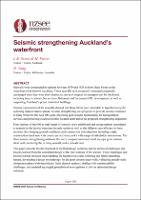| dc.description.abstract | Seawalls were constructed in sections between 1879 and 1925 to form Quay Street on the waterfront of Downtown Auckland. These seawalls have essentially remained structurally unchanged since they were first constructed and now support the transport hub for Auckland, including ferry terminals, bus services, Britomart and the current CRL development, as well as supporting Auckland’s prime waterfront buildings.
Seismic assessments of the seawalls showed that Quay Street was vulnerable to liquefaction/cyclic softening induced lateral spread. Seismic strengthening was proposed to provide seismic resilience to Quay Street for the next 100 years, providing post-disaster functionality for transportation services and protecting essential utilities located landward of the proposed strengthening alignment.
Four sections of the 600 m total length of seawalls were established and design options considered to respond to the desired outcomes in each section as well as the different seawall types in these sections, the changing ground conditions, and construction considerations including a tight construction timeframe with concurrent activities, and a wide range of stakeholder interactions. The three seismic strengthening solutions that were designed and constructed are a jet grout column shear wall, anchoring the existing seawall, and a palisade wall.
This paper presents the development of the final design solutions and the technical challenges and lessons learned from the concurrent design of the four sections of the seawall. These challenges and lessons learned included understanding the liquefaction/cyclic softening and lateral spreading hazard, developing a design methodology for jet grout column shear walls, validating pseudo-static design procedures with time history finite element analysis, dealing with constructability challenges, and undertaking staged geotechnical investigations to deliver optimised design solutions. | |

